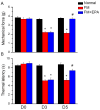Eicosapentaenoic Acid Modulates Transient Receptor Potential V1 Expression in Specific Brain Areas in a Mouse Fibromyalgia Pain Model
- PMID: 38474148
- PMCID: PMC10932372
- DOI: 10.3390/ijms25052901
Eicosapentaenoic Acid Modulates Transient Receptor Potential V1 Expression in Specific Brain Areas in a Mouse Fibromyalgia Pain Model
Abstract
Pain is an unpleasant sensory and emotional experience accompanied by tissue injury. Often, an individual's experience can be influenced by different physiological, psychological, and social factors. Fibromyalgia, one of the most difficult-to-treat types of pain, is characterized by general muscle pain accompanied by obesity, fatigue, sleep, and memory and psychological concerns. Fibromyalgia increases nociceptive sensations via central sensitization in the brain and spinal cord level. We used intermittent cold stress to create a mouse fibromyalgia pain model via a von Frey test (day 0: 3.69 ± 0.14 g; day 5: 2.13 ± 0.12 g). Mechanical pain could be reversed by eicosapentaenoic acid (EPA) administration (day 0: 3.72 ± 0.14 g; day 5: 3.69 ± 0.13 g). A similar trend could also be observed for thermal hyperalgesia. The levels of elements in the transient receptor potential V1 (TRPV1) signaling pathway were increased in the ascending pain pathway, including the thalamus, medial prefrontal cortex, somatosensory cortex, anterior cingulate cortex, and cerebellum. EPA intake significantly attenuated this overexpression. A novel chemogenetics method was used to inhibit SSC and ACC activities, which presented an analgesic effect through the TRPV1 downstream pathway. The present results provide insights into the role of the TRPV1 signaling pathway for fibromyalgia and its potential as a clinical target.
Keywords: TRPV1; eicosapentaenoic acid; fibromyalgia; mPFC; thalamus.
Conflict of interest statement
There are no financial or other relationships that might lead to conflicts of interest for all authors.
Figures









Similar articles
-
Accurate Chemogenetics Determines Electroacupuncture Analgesia Through Increased CB1 to Suppress the TRPV1 Pathway in a Mouse Model of Fibromyalgia.Life (Basel). 2025 May 20;15(5):819. doi: 10.3390/life15050819. Life (Basel). 2025. PMID: 40430245 Free PMC article.
-
Acupoint Catgut Embedding Diminishes Fibromyalgia Pain through TRPV1 in the Mouse Brain.J Integr Neurosci. 2023 Jul 17;22(4):97. doi: 10.31083/j.jin2204097. J Integr Neurosci. 2023. PMID: 37519181
-
Acupoint catgut embedding attenuates fibromyalgia pain through attenuation of TRPV1 signaling pathway in mouse.Iran J Basic Med Sci. 2024;27(1):66-73. doi: 10.22038/IJBMS.2023.71431.15534. Iran J Basic Med Sci. 2024. PMID: 38164490 Free PMC article.
-
Are tender point injections beneficial: the role of tonic nociception in fibromyalgia.Curr Pharm Des. 2006;12(1):23-7. Curr Pharm Des. 2006. PMID: 16454721 Review.
-
Current experience with 5-HT3 receptor antagonists in fibromyalgia.Rheum Dis Clin North Am. 2002 May;28(2):319-28. doi: 10.1016/s0889-857x(01)00014-x. Rheum Dis Clin North Am. 2002. PMID: 12122920 Review.
Cited by
-
Electroacupuncture Reduced Fibromyalgia-Pain-like Behavior through Inactivating Transient Receptor Potential V1 and Interleukin-17 in Intermittent Cold Stress Mice Model.Brain Sci. 2024 Aug 28;14(9):869. doi: 10.3390/brainsci14090869. Brain Sci. 2024. PMID: 39335365 Free PMC article.
-
Dietary omega-3 polyunsaturated fatty acids reduce cytochrome c oxidase in brain white matter and sensorimotor regions while increasing functional interactions between neural systems related to escape behavior in postpartum rats.Front Syst Neurosci. 2024 Oct 31;18:1423966. doi: 10.3389/fnsys.2024.1423966. eCollection 2024. Front Syst Neurosci. 2024. PMID: 39544360 Free PMC article.
-
A Review of the Application of Myofascial Release Therapy in the Treatment of Diseases.J Multidiscip Healthc. 2024 Sep 26;17:4507-4517. doi: 10.2147/JMDH.S481706. eCollection 2024. J Multidiscip Healthc. 2024. PMID: 39351042 Free PMC article. Review.
-
Nutritional Strategies for Chronic Craniofacial Pain and Temporomandibular Disorders: Current Clinical and Preclinical Insights.Nutrients. 2024 Aug 27;16(17):2868. doi: 10.3390/nu16172868. Nutrients. 2024. PMID: 39275184 Free PMC article. Review.
References
-
- Masood R., Mandalia K., Moverman M.A., Puzzitiello R.N., Pagani N.R., Menendez M.E., Salzler M.J. Patients with Functional Somatic Syndromes-Fibromyalgia, Irritable Bowel Syndrome, Chronic Headaches, and Chronic Low Back Pain-Have Lower Outcomes and Higher Opioid Usage and Cost After Shoulder and Elbow Surgery. Arthroscopy. 2023;39:1529–1538. doi: 10.1016/j.arthro.2022.12.028. - DOI - PubMed
MeSH terms
Substances
Grants and funding
LinkOut - more resources
Full Text Sources
Medical
Research Materials

